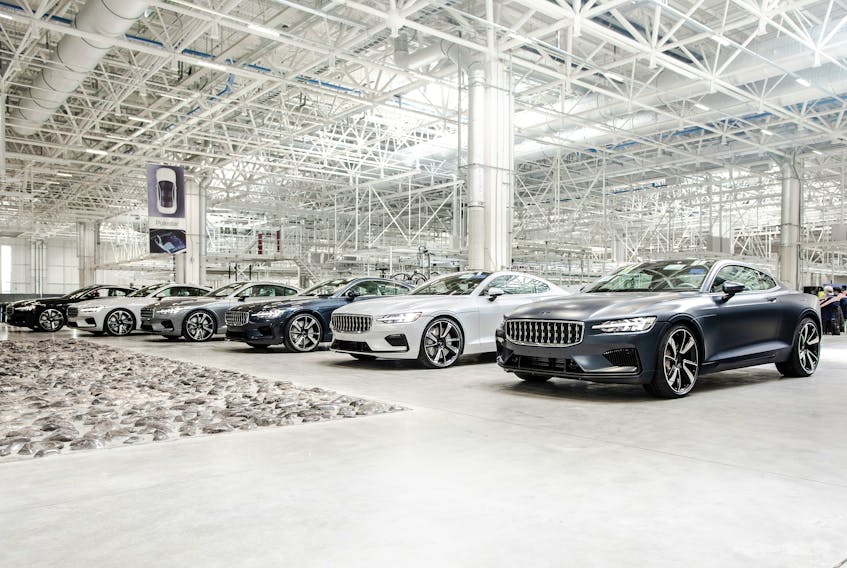GENEVA — Polestar is a flashy startup offering sleek electric cars to the masses. Sound familiar? We’ve seen this before, most notably from Tesla.
Polestar appears, at first glance, to be yet another slick Silicon Valley operation. Its website has the same simplified, low-pressure, soft-sell aesthetic used by so many other millennial-approved brands like Glossier, Outdoor Voices and Casper. The Polestar 2, the brand’s entry-level car due out in 2020, advertises “vegan-friendly interior materials.” The company, “feels that car ownership should more closely resemble phone ownership: an all-inclusive monthly fee.”
The Swedish-Chinese firm is, in fact, a major automaker dressed in socially-responsible clothing and well-versed in start-up-speak. The brand is an offshoot of Volvo and its Chinese parent company Geely.
Polestar was the brainchild of a handful of key people, including Håkan Samuelsson, CEO of Volvo, Li Shufu, billionaire founder and chairman of Geely, and Volvo’s chief designer Thomas Ingenlath, who now also serves as Polestar’s CEO.

There is no shortage of up-start automakers vying to deliver mid-priced EVs. Why should customers put their trust — and a $1,500 deposit — on Polestar?
“Because of the reputation that Volvo and Geely gained over the last six or seven years,” Ingenlath says. Volvo was basically dead in the water when Geely rescued it in 2010. The Chinese company gave the Swedes the cash they needed to develop a fresh new range of cars and SUVs. The results — including the Volvo XC90, V60 and XC40 — are indeed excellent. “That was certainly a big promise and we delivered,” says Ingenlath, banging his knuckle on the table for added impact.
The Polestar 2 pictured here is not a concept. “Somebody asked me, ‘how much will the production car look like that?’” And, well, that is the production car,” says Ingenlath. “People should have trust in our capability to deliver.”
In Canada, the first Polestar 2 models will cost $69,900. The company is targeting a 275 mile (442 km) EPA-rated driving range. Top-spec models should be zippy, with two electric motors providing all-wheel drive, 408 horsepower and 487 lb-ft of torque. That’s enough to get the four-door hatchback from 0-100 km/h in under five seconds. It should handle too, with Brembo brakes and exotic Öhlins dampers.
Production starts in early 2020 at a factory in China owned by Geely and operated by Volvo. The first cars should arrive in Canada in the first half of that year, according to Ingenlath.

“A $40,000-Euro car is not cheap, I acknowledge that,” he says, “but it’s not an unusual amount of money to spend for a car, so I think we reached a level where it’s accessible.”
The limited-edition, high-performance Polestar 1, rings in at US$155,000. The team discussed keeping Polestar as a high-luxury brand, but decided to move down-market. “To actually really get electro-mobility going and move people, we cannot do that if we are up there in the clouds,” Ingenlath says.
Work started on developing Polestar as a spinoff brand in 2016, as Volvo was still in the middle of its re-launch. A year earlier, Volvo purchased Polestar, which up until that point had been an independent Volvo tuner and racing team.
As Ingenlath tells it, electric cars emerged as the technology for the future; and it became clear certain products wouldn’t fit into Volvo’s lineup. The 40.2 concept car unveiled in 2016 — which became the Polestar 2 — was originally a Volvo. But back then, “everybody was going, ‘oh, but it’s not a hatchback, it’s too small, it’s too big, it’s too expensive, it’s too cheap.’” The critics were right though, he adds; it wouldn’t have fit into the existing Volvo range.
“We realized this is much more a product for a start-up company that does not have to serve an established customer base,” Ingenlath explains. “The Polestar 2 suddenly felt like, come on, let’s do that as the next car: this is where it’s really hot. This is of course where the [Tesla] Model 3 was; it was really inspiring to see how much it resonated with the public. And still, today, there’s hardly any competitor to it.”
It’s 2019, and there is indeed a glaring lack of desirable electric cars under-$55,000, cars that have the requisite range and cabin quality to justify such prices. Arguably, the Model 3 is the only one.
“This is not about making a Tesla 3 competitor,” Ingenlath says. “This is about actually tempting a BMW 3 Series customer to try a Polestar 2, someone who is buying Mercedes, Audi, Jaguar or whatever to actually try an electric car.”
On paper, Polestar has a winning formula. The on-point Scandinavian design, purpose-built electric architecture, minimalist branding, and simplified direct-to-consumer sales model should be cat-nip for a certain type of young-ish urbanite. That same basic formula works for mattresses, makeup, workout clothes and just about everything else — provided the products are actually good. For Polestar, the proof will be in the driving.









